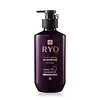What's inside
What's inside
 Key Ingredients
Key Ingredients

 Benefits
Benefits

 Concerns
Concerns

 Ingredients Side-by-side
Ingredients Side-by-side

Aloe Barbadensis Leaf Juice
Skin ConditioningWater
Skin ConditioningSodium Coco-Sulfate
CleansingSodium Laurylglucosides Hydroxypropylsulfonate
CleansingDecyl Glucoside
CleansingCedrus Atlantica Bark Oil
MaskingCitrus Aurantifolia Oil
CleansingCitrus Aurantium Dulcis Peel Oil
MaskingCitrus Grandis Peel Oil
MaskingCitrus Limon Peel Oil
MaskingLitsea Cubeba Fruit Oil
MaskingCalendula Officinalis Flower Extract
MaskingChamomilla Recutita Flower Extract
MaskingChenopodium Quinoa Seed
AbrasiveCitrus Limon Peel Extract
EmollientStyrax Benzoin Resin Extract
MaskingTocopheryl Acetate
AntioxidantBabassu Oil Polyglyceryl-4 Esters
Bisabolol
MaskingCitric Acid
BufferingCoco-Glucoside
CleansingGlyceryl Oleate
EmollientInulin
Skin ConditioningSodium Chloride
MaskingSodium Phytate
Sodium Sulfate
Alcohol
AntimicrobialBenzyl Alcohol
PerfumingPotassium Sorbate
PreservativeSodium Benzoate
MaskingCitral
PerfumingLimonene
PerfumingAloe Barbadensis Leaf Juice, Water, Sodium Coco-Sulfate, Sodium Laurylglucosides Hydroxypropylsulfonate, Decyl Glucoside, Cedrus Atlantica Bark Oil, Citrus Aurantifolia Oil, Citrus Aurantium Dulcis Peel Oil, Citrus Grandis Peel Oil, Citrus Limon Peel Oil, Litsea Cubeba Fruit Oil, Calendula Officinalis Flower Extract, Chamomilla Recutita Flower Extract, Chenopodium Quinoa Seed, Citrus Limon Peel Extract, Styrax Benzoin Resin Extract, Tocopheryl Acetate, Babassu Oil Polyglyceryl-4 Esters, Bisabolol, Citric Acid, Coco-Glucoside, Glyceryl Oleate, Inulin, Sodium Chloride, Sodium Phytate, Sodium Sulfate, Alcohol, Benzyl Alcohol, Potassium Sorbate, Sodium Benzoate, Citral, Limonene
Water
Skin ConditioningSodium Laureth Sulfate
CleansingAmmonium Lauryl Sulfate
CleansingGlycerin
HumectantCocamide Mea
EmulsifyingParfum
MaskingDisodium Laureth Sulfosuccinate
CleansingLauryl Hydroxysultaine
CleansingCaffeine
Skin ConditioningPPG-3 Caprylyl Ether
SolventAlcohol Denat.
AntimicrobialPhenoxyethanol
PreservativeSodium Benzoate
MaskingCetyl Alcohol
EmollientMenthol
MaskingGuar Hydroxypropyltrimonium Chloride
Skin ConditioningCitric Acid
BufferingSodium Salicylate
PreservativeCaprylic/Capric Triglyceride
MaskingTrihydroxystearin
Skin ConditioningSodium Citrate
BufferingDicaprylyl Ether
EmollientTetrasodium EDTA
Butylene Glycol
HumectantMalt Extract
Skin ProtectingDisodium EDTA
Linalool
PerfumingPEG-45m
HumectantGlyceryl Stearate
EmollientMentha Arvensis Leaf Extract
MaskingBenzyl Salicylate
PerfumingHexyl Cinnamal
PerfumingBenzyl Benzoate
AntimicrobialGeraniol
PerfumingAlpha-Isomethyl Ionone
PerfumingHydrolyzed Corn Starch
HumectantCaprylyl Glycol
EmollientPinus Densiflora Leaf Extract
Antimicrobial1,2-Hexanediol
Skin ConditioningDehydroacetic Acid
PreservativePanax Ginseng Extract
AntioxidantPanax Ginseng Root Extract
EmollientSilica
AbrasiveZingiber Officinale Root Extract
MaskingEthylhexylglycerin
Skin ConditioningTocopherol
AntioxidantOryza Sativa Extract
AbsorbentImperata Cylindrica Root Extract
Skin ConditioningScutellaria Baicalensis Root Extract
AstringentSesamum Indicum Seed Extract
Skin ConditioningLonicera Japonica Flower Extract
Skin ConditioningCalendula Officinalis Flower Extract
MaskingTribulus Terrestris Fruit Extract
Skin ConditioningCamellia Japonica Seed Oil
EmollientCamellia Sinensis Seed Oil
HumectantPEG-150 Pentaerythrityl Tetrastearate
EmulsifyingPPG-2 Hydroxyethyl Cocamide
EmulsifyingPolygonum Multiflorum Root Extract
Skin ConditioningWater, Sodium Laureth Sulfate, Ammonium Lauryl Sulfate, Glycerin, Cocamide Mea, Parfum, Disodium Laureth Sulfosuccinate, Lauryl Hydroxysultaine, Caffeine, PPG-3 Caprylyl Ether, Alcohol Denat., Phenoxyethanol, Sodium Benzoate, Cetyl Alcohol, Menthol, Guar Hydroxypropyltrimonium Chloride, Citric Acid, Sodium Salicylate, Caprylic/Capric Triglyceride, Trihydroxystearin, Sodium Citrate, Dicaprylyl Ether, Tetrasodium EDTA, Butylene Glycol, Malt Extract, Disodium EDTA, Linalool, PEG-45m, Glyceryl Stearate, Mentha Arvensis Leaf Extract, Benzyl Salicylate, Hexyl Cinnamal, Benzyl Benzoate, Geraniol, Alpha-Isomethyl Ionone, Hydrolyzed Corn Starch, Caprylyl Glycol, Pinus Densiflora Leaf Extract, 1,2-Hexanediol, Dehydroacetic Acid, Panax Ginseng Extract, Panax Ginseng Root Extract, Silica, Zingiber Officinale Root Extract, Ethylhexylglycerin, Tocopherol, Oryza Sativa Extract, Imperata Cylindrica Root Extract, Scutellaria Baicalensis Root Extract, Sesamum Indicum Seed Extract, Lonicera Japonica Flower Extract, Calendula Officinalis Flower Extract, Tribulus Terrestris Fruit Extract, Camellia Japonica Seed Oil, Camellia Sinensis Seed Oil, PEG-150 Pentaerythrityl Tetrastearate, PPG-2 Hydroxyethyl Cocamide, Polygonum Multiflorum Root Extract
 Reviews
Reviews

Ingredients Explained
These ingredients are found in both products.
Ingredients higher up in an ingredient list are typically present in a larger amount.
Calendula Officinalis Flower Extract comes from the common Marigold plant. This ingredient is a skin conditioner.
Marigolds contain flavonoids. Flavonoids are a group of substances found naturally in plants. They possess antioxidant and inflammation properties.
This ingredient soothes skin inflammation by inhibiting inhibiting a part of the inflammation process.
Marigolds have been used in traditional medicine throughout Asia and Europe.
Learn more about Calendula Officinalis Flower ExtractCitric Acid is an alpha hydroxy acid (AHA) naturally found in citrus fruits like oranges, lemons, and limes.
Like other AHAs, citric acid can exfoliate skin by breaking down the bonds that hold dead skin cells together. This helps reveal smoother and brighter skin underneath.
However, this exfoliating effect only happens at high concentrations (20%) which can be hard to find in cosmetic products.
Due to this, citric acid is usually included in small amounts as a pH adjuster. This helps keep products slightly more acidic and compatible with skin's natural pH.
In skincare formulas, citric acid can:
While it can provide some skin benefits, research shows lactic acid and glycolic acid are generally more effective and less irritating exfoliants.
Most citric acid used in skincare today is made by fermenting sugars (usually from molasses). This synthetic version is identical to the natural citrus form but easier to stabilize and use in formulations.
Read more about some other popular AHA's here:
Learn more about Citric AcidSodium Benzoate is a preservative. It's used in both cosmetic and food products to inhibit the growth of mold and bacteria. It is typically produced synthetically.
Both the US FDA and EU Health Committee have approved the use of sodium benzoate. In the US, levels of 0.1% (of the total product) are allowed.
Sodium benzoate works as a preservative by inhibiting the growth of bacteria inside of cells. It prevents the cell from fermenting a type of sugar using an enzyme called phosphofructokinase.
It is the salt of benzoic acid. Foods containing sodium benzoate include soda, salad dressings, condiments, fruit juices, wines, and snack foods.
Studies for using ascorbic acid and sodium benzoate in cosmetics are lacking, especially in skincare routines with multiple steps.
We always recommend speaking with a professional, such as a dermatologist, if you have any concerns.
Learn more about Sodium BenzoateWater. It's the most common cosmetic ingredient of all. You'll usually see it at the top of ingredient lists, meaning that it makes up the largest part of the product.
So why is it so popular? Water most often acts as a solvent - this means that it helps dissolve other ingredients into the formulation.
You'll also recognize water as that liquid we all need to stay alive. If you see this, drink a glass of water. Stay hydrated!
Learn more about Water